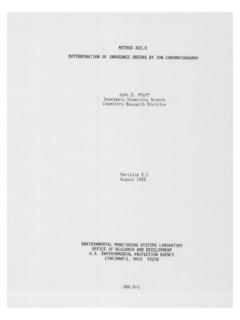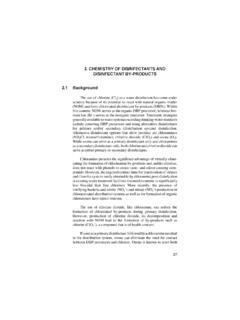Transcription of Method 300.0 Determination of Inorganic Anions …
1 Method Determination OF Inorganic Anions BY ION CHROMATOGRAPHY John D. Pfaff Inorganic Chemistry Branch Chemistry Research Division Revision August 1993 ENVIRONMENTAL MONITORING SYSTEMS LABORATORY OFFICE OF RESEARCH AND DEVELOPMENT ENVIRONMENTAL PROTECTION AGENCY CINCINNATI, OHIO 45268 Method Determination OF Inorganic Anions BY ION CHROMATOGRAPHY SCOPE AND APPLICATION This Method covers the Determination of the following Inorganic Anions : PART A. Bromide Nitrite Chloride Ortho-Phosphate-P Fluoride Sulfate Nitrate PART B. Bromate chlorite chlorate The matrices applicable to each Method are shown below: Drinking water, surface water, mixed domestic and industrial wastewaters, groundwater, reagent waters, solids (after extraction ), leachates (when no acetic acid is used).
2 Drinking water and reagent waters The single laboratory Method Detection Limit (MDL defined in Section ) for the above analytes is listed in Tables 1A and 1B. The MDL for a specific matrix may differ from those listed, depending upon the nature of the sample. Method A is recommended for drinking and wastewaters. The multilaboratory ranges tested for each anion are as follows: Analyte mg/L Bromide - Chloride - Fluoride - Nitrate-N - Nitrite-N - Otho-Phosphate-P - Sulfate - This Method is recommended for use only by or under the supervision of analysts experienced in the use of ion chromatography and in the interpretation of the resulting ion chromatograms.
3 When this Method is used to analyze unfamiliar samples for any of the above Anions , anion identification should be supported by the use of a fortified sample matrix covering the Anions of interest. The fortification procedure is described in Section Users of the Method data should state the data-quality objectives prior to analysis. Users of the Method must demonstrate the ability to generate acceptable results with this Method , using the procedures described in Section SUMMARY OF Method A small volume of sample, typically 2-3 mL, is introduced into an ion chromatograph.
4 The Anions of interest are separated and measured, using a system comprised of a guard column, analytical column, suppressor device, and conductivity detector. The main differences between Parts A and B are the separator columns and guard columns. Sections and will elicit the differences. An extraction procedure must be performed to use this Method for solids (See Section ). Limited performance-based Method modifications may be acceptable provided they are fully documented and meet or exceed requirements expressed in Section , Quality Control. DEFINITIONS Calibration Blank (CB) -- A volume of reagent water fortified with the same matrix as the calibration standards, but without the analytes, internal standards, or surrogate analytes.
5 Calibration Standard (CAL) -- A solution prepared from the primary dilution standard solution or stock standard solutions and the internal standards and surrogate analytes. The CAL solutions are used to calibrate the instrument response with respect to analyte concentration. Field Duplicates (FD) -- Two separate samples collected at the same time and placed under identical circumstances and treated exactly the same throughout field and laboratory procedures. Analyses of field duplicates indicate the precision associated with sample collection, preservation and storage, as well as with laboratory procedures.
6 Instrument Performance Check Solution (IPC) -- A solution of one or more Method analytes, surrogates, internal standards, or other test substances used to evaluate the performance of the instrument system with respect to a defined set of criteria. Laboratory Fortified Blank (LFB) -- An aliquot of reagent water or other blank matrices to which known quantities of the Method analytes are added in the laboratory. The LFB is analyzed exactly like a sample, and its purpose is to determine whether the methodology is in control, and whether the laboratory is capable of making accurate and precise measurements.
7 Laboratory Fortified Sample Matrix (LFM) -- An aliquot of an environmental sample to which known quantities of the Method analytes are added in the laboratory. The LFM is analyzed exactly like a sample, and its purpose is to determine whether the sample matrix contributes bias to the analytical results. The background concentrations of the analytes in the sample matrix must be determined in a separate aliquot and the measured values in the LFM corrected for background concentrations. Laboratory Reagent Blank (LRB) -- An aliquot of reagent water or other blank matrices that are treated exactly as a sample including exposure to all glassware, equipment, solvents, reagents, internal standards, and surrogates that are used with other samples.
8 The LRB is used to determine if Method analytes or other interferences are present in the laboratory environment, the reagents, or the apparatus. Linear Calibration Range (LCR) -- The concentration range over which the instrument response is linear. Material Safety Data Sheet (MSDS) -- Written information provided by vendors concerning a chemical's toxicity, health hazards, physical properties, fire, and reactivity data including storage, spill, and handling precautions. Method Detection Limit (MDL) -- The minimum concentration of an analyte that can be identified, measured and reported with 99% confidence that the analyte concentration is greater than zero.
9 Performance Evaluation Sample (PE) -- A solution of Method analytes distributed by the Quality Assurance Research Division (QARD), Environmental Monitoring Systems Laboratory (EMSL-Cincinnati), U. S. Environmental Protection Agency, Cincinnati, Ohio, to multiple laboratories for analysis. A volume of the solution is added to a known volume of reagent water and analyzed with procedures used for samples. Results of analyses are used by QARD to determine statistically the accuracy and precision that can be expected when a Method is performed by a competent analyst. Analyte true values are unknown to the analyst.
10 Quality Control Sample (QCS) -- A solution of Method analytes of known concentrations that is used to fortify an aliquot of LRB or sample matrix. The QCS is obtained from a source external to the laboratory and different from the source of calibration standards. It is used to check laboratory performance with externally prepared test materials. Stock Standard Solution (SSS) -- A concentrated solution containing one or more Method analytes prepared in the laboratory using assayed reference materials or purchased from a reputable commercial source. INTERFERENCES Interferences can be caused by substances with retention times that are similar to and overlap those of the anion of interest.













